The Stallion Responsive SEO Theme includes built in support for the WP Robot Autoblog Plugin and the Massive Passive Profits Autoblog Plugin (the developer doesn’t appear to support this any more).
Autoblog Plugin Features
Both WordPress autoblog plugins scrape web content from various online sources including Amazon, YouTube and RSS feeds, the scraped content is considered duplicate content by Google and if Google determines your WordPress blog is an autoblog it will be slapped with a Google duplicate content penalty.
To date (from YEARS of SEO tests with autoblogs) I’ve not found a way to completely prevent Google penalizing autoblogs long term (give them a couple of years and they tend to be penalized in Google).
Any Internet marketer etc… who tries to tell you autoblogs are not downgraded by Google is full of shit. It’s not will an autoblog be downgraded in Google, it’s WHEN.
Make Money Autoblogging
We can’t stop Google penalizing WordPress autoblogs, but we can make it harder for Google to determine your site is using an autoblog by hiding obvious autoblog footprints.
For both autoblog plugins Stallion Responsive replaces nofollow affiliate links with cloaked javascript links protecting valuable link benefit and removing a thin affiliate footprint search engines can easily track.
Also replaces Amazon buy now images with a buy now image you choose again hiding another obvious auto blog and thin affiliate site footprint.
Read my WP Robot Review and take advantage of the generous discount code (enter the code: “Stallion” at checkout) Thomas Höfter (WP Robot developer) kindly provided.
Enjoy autoblogging with WordPress and the Stallion Responsive WordPress SEO Theme Package.
You can make good money using WordPress autoblog plugins, but NEVER add an autoblog to an important website! If a domain you own is already making money online, adding an autoblog long term is the domains death sentence for Google rankings.
David Law

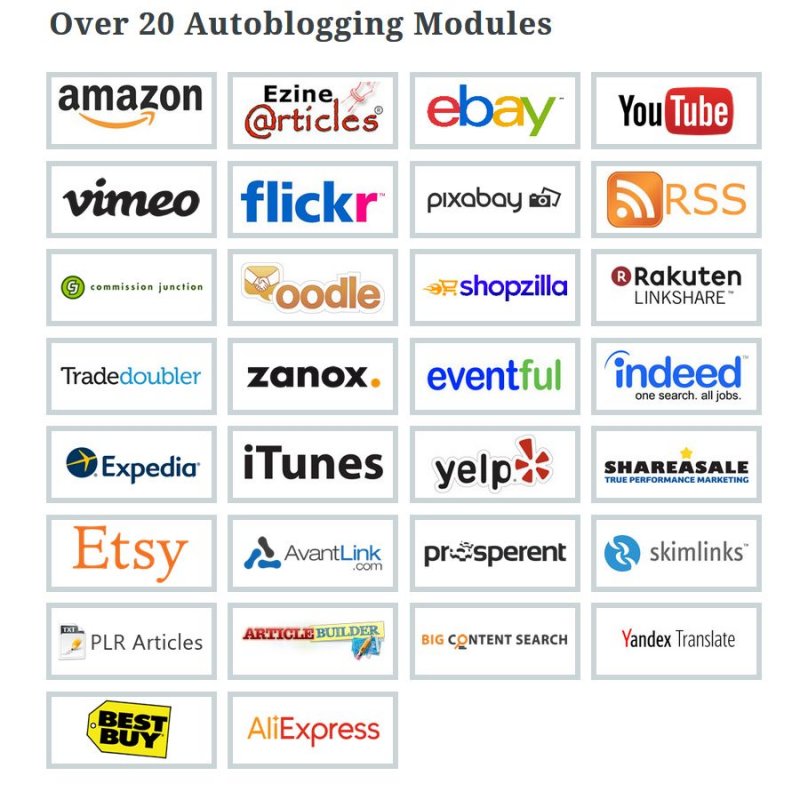
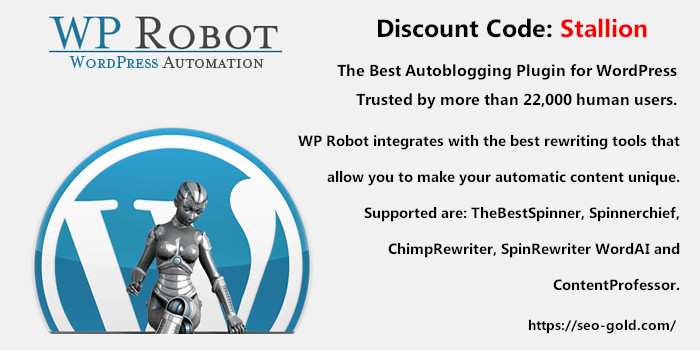
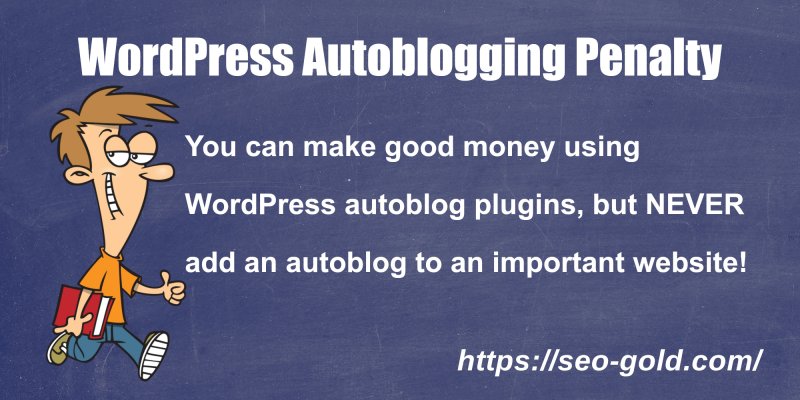



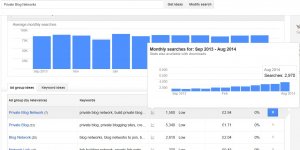


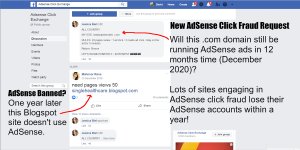


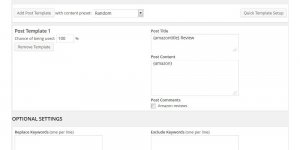
I still disagree with you. Why? Over 123 blogs operating on autopilot and 5 more Authority sites that all list on the first page of Google and over 75 (estimate) of those which rank in the Top 3 listings or at Number #1 for their keywords.
Why?
I tell Google what is important on my sites and what I want it to look at. By using a focused SEO methodology you can channelize the GoogleBot and tell it what you want to be indexed from your sites. If you want, you can have nice Authority Links in your Search listings by using Categories instead of Tags, but for the most part, I only allow my Tag pages to be indexed.
This creates a funnel and minimizes any and all duplicate content. The funnel is created by the Tag Pages created by WordPress and then inner linked though WordPress and the Tags listed at the bottom of every article creating a randomized link structure through your site.
Then you backlink Tag pages based on your site’s Primary and Related Keywords. These keywords are used to focus Google’s attention. We then take these keywords and funnel them to dedicated, keyword optimized pages/posts on the blog. You then use more internal linking to show Google that these are your Authority Pages and you funnel your PR to them, not to mention, keyword focus. This focus is enhanced by external linking and backlinks, focused on the same keywords.
I have tested your very same methodology extensively and my sites have dropped in rank every single time I opened the index doors to my Search, Date, and Category/ Tag archives at the same time. When I have closed the funnel and only allowed either Tag or Category pages to be indexed, the best results have been through Tag pages every single time. I only allow categories when I am building a site for authority and want the Category listings to be shown in the search index.
Mike
That’s not SEO proof. You can get lots of SEO factors wrong and still get great search engine rankings if you are good at generating backlinks and have reasonably well search engine optimized content (with enough backlinks you don’t even need great SEO content) or they are easy SERPs.
Look at the Computers SERP in Google, Dell is number 1, and it’s really badly search engine optimized for the Computers SERP, but it’s PR8 home page is a result of a LOT of backlinks and many will link with anchor text “Dell Computers” and similar. They have so much off site SEO (backlinks) they take a very competitive SERP with practically no on page SEO. Imagine the Computer related long tail SERPs they are missing out on though!
If you got more SEO factors right you’d generate even more SERPs and more money.
Makes no difference to me if you believe me or not, my sites currently pull in over 40,000 unique visitors a day and they are ‘hobby’ sites, they aren’t my main income (my SEO business is my main income).
BTW I wasn’t advocating you have every type of archive possible on a WordPress site, quite the opposite. You only use Tags, I only use Categories for the same reason, (I work on the principle if you can add a Tag to a page, you can create a similar Category instead: I prefer Categories over Tags, but they are pretty much the same thing) though appears you don’t understand why having so many types of archives are so damaging SEO wise:
Date archives are SEO damaging because they add very little to a sites SEO (they help get deep content indexed, but Categories/Tags are better) while taking valuable link benefit away from important pages of a site. Add to this when you add the Archives widget you get 12 links with awful anchor text, anchor text is one of the most important SEO factors on a page, you do not want 12 links on every page of a site with a month as anchor text!!!
Search pages don’t damage a sites SEO, WordPress doesn’t link directly to them. If you happen to get a dumb bot spidering search pages, it’s free low quality links (very little gain, but no SEO damage).
Categories and Tags are useful archives, they act as a sitemap (way for spiders to navigate a site) while adding SEO wise to the site as long as the Categories/Tags are optimised.
If you call your Categories/Tags Cat 1, Cat 2 etc… it’s as bad as having the monthly archives. Name them with relevant keywords like “AdSense WordPress Themes” (one of this sites Categories) and you not only have a set of pages on the site targeting that and related SERPs, the anchor text can help the pages the Category links are on (anchor text is very important).
I generally only use Categories (have the odd Tag here and there) because I try not to waste link benefit on pages that don’t add anything to the site.
WordPress users who create hundreds of Tags and link most of their content with the same Tags are potentially wasting a lot of link benefit on duplicate pages (fortunately Google is good at dealing with duplicate content): as WordPress updates, my posts are compatible with the latest version of WordPress, if I added all the posts to Tags WordPress 3.0, WordPress 3.1, WordPress 3.2 etc… all those Tags would hold the same content (duplicated). If Google fails to combine the results into one pages SERPs, I’ve wasted link benefit for no gain (only one of them is likely to rank well as they have the same content).
If like me you only add Categories/Tags that add something to a site (so not creating them rather than noidexing them like the WordPress SEO plugins offer) I wouldn’t be surprised that your sites would drop in rankings if you tested adding monthly archives and extra Categories/Tags that add nothing SEO wise. Your link benefit is spread thinner (less link benefit to your posts) and your on page SEO is diluted by having wasted anchor text (the dated archives and calendar archives are the worst).
If you use nofollow to ‘hide’ your monthly archives (nofollow ‘hides’ the link to Google) you will almost certainly get better results by removing the archives widget from your site, you’ll not waste link benefit on the dated archive links. Noindex isn’t as bad, but it does waste link benefit.
David
I don’t have time to write a lengthy reply here, but this last post shows that our thought process is largely the same on most factors even though I didn’t talk much about on Page and in content optimization, we have similar mindsets. I agree with you on a lot of what you are saying.
I don’t use Archive widgets. I prefer to enhance my inner linking by providing links to related posts, my categories, and Tags. I don’t link directly to Archives because of the SEO factors.
I focus my SEO Plan of Action on the combination of all factors and I am able to use any theme in doing so.
Good article. You sure have provoked some good responses here, but you are not right about everything you think you are.
Mike
I see you do WordPress autoblogs.
After your last comment (the one starting “123 blogs operating on autopilot” I realised we weren’t 100 miles from using similar SEO techniques :-)
I did find a couple of your sites (found your Twitter account) and saw you have a nofollow attribute on your home page link from what I assume is your main site.
Might be an oversight on your part (I still have pages with nofollow dotted around from when Google respected the original reason for nofollow). Using nofollow is a LOT worse than noindex.
I’ve recently started looking into WordPress autoblog plugins, known about auto-blogging for years but most of the software wasn’t very good and autoblogs do tend to be downgraded over time (used to get tens of thousands of visitors a day to Amazon thin affiliate sites which are not unlike autoblogs on autopilot: thin/duplicate content which Google hates).
I’m curious are you offering another WordPress autoblog plugin or only explaining how to use current autoblog plugins effectively?
Did look at one of your autoblog test sites, saw a lot of nofollow links. I guess you don’t agree nofollow deletes link benefit (see the Matt Cutts quote in one of the earlier comments)?
I’ve been playing around with a popular autoblog WordPress plugin (it also uses nofollow affiliate links) and made myself an SEO’d version of the plugin and an edited version of my Talian SEO theme for that autoblog plugin that hides the affiliate links rather than nofollow’s them (all the autoblog plugins I’ve looked at use nofollow on affiliate links).
David
The main reason for using the nofollow attribute on the sites is to purposely not give credit to the affiliate links there. Being that Google only recognizes the first 100 links on a page, I like to make sure it is only indexing and following the links I want it to. Therefore Google will not then look at my sites as thin affiliate sites.
My course has some software but not a pure auto blogging plugin. I recommend several very good tools to my members and show them how to use them in my course, but I focus on creating SEO Friendly, value added sites and not SPAM Blogs or junk “quickie” sites. These old techniques do not work and only sites that add value to users and the web work as auto blogs. So I tend to describe my Course and a way to build value added blogs that run on auto as opposed to pure auto blogs. Unique content is required on these sites as well.
I would be interested to hear how you cloak your links from Google without using the nofollow in them. Email me if you do not want to post it here.
Mike
Google’s never limited the number of links it will follow from a page to 100.
There used to be a 100KB indexing limit, where Google would only index the first 100KB (code wise) of a page, but it dropped that limitation years ago.
Google and many SEO’s advise trying to limit the number of links from a page to under 100, but it’s an SEO guideline (an arbitrary one at that), not a limit per se (Googlebot will spider more than 100 links from a page: have tested this).
When the Googlebot hits a page it randomly follows links from the page, if you have 100 links there’s a 1 in 100 chance of any one link being followed. Googlebot doesn’t limit itself to following only one link per visit, but for the sake of ease of understanding if it did, the Googlebot would find it extremely difficult to follow all 100 links from a page over a reasonable period of time.
The SEO argument is by limiting the number of links from a page to below 100 the probability of links not being followed and their respective pages spidered by Googlebot is significantly reduced.
I’ve never deliberately limited the number of links from a page to below 100, add as many links as are needed, and have tested a links page with over 1,000 links where I added pages not linked from anywhere else and they were eventually spidered from that page (took a while mind you).
Basically if you have sites with a lot of Categories (Tags in your case :-)) for example because many of your pages have those links, the probability of some being missed is very low.
There is also the argument of how many links a particular page can support and what you are trying to achieve SEO wise.
If you have a page (Page A) with one backlink to it from a page (Page B) without any good backlinks to it, Page A would not be a good choice for a links page with 200+ links to pages you wanted indexing fast. Page A won’t be visited very often and some of the 200 links might not be spidered from that page for months/years.
So on a site with hardly any backlinks it’s going to struggle with pages with a lot of links, but a site with a lot of backlinks can handle pages with a lot of links from the pages.
With regards hiding affiliate links, I’ll drop you an email with a link to one of my test sites using WPRobot, every nofollow link is hidden via a combination of hacking the WPRobot module files and an edited version of my Talian theme. Been meaning to try to find the time to achieve similar without having to resort to hacking the modules (make it a theme feature, have a lot of customers who autoblog), but I’ve gone as far as replacing the links the eBay module creates (that are served by eBay) so there are NO nofollow links and no links a search engine spider can follow from the thin content. The added benefit of this is it hides the thin affiliate footprint, search engine bots don’t see links to Amazon etc…
Since Google deletes the link benefit that would have gone through a nofollow link I’d never use them on an internal link (linking to Categories for example). You could argue as you don’t really want to send an affiliate link, link benefit (helps them rank better than you) even though nofollow deletes link benefit, as you don’t want to send it to an affiliate that can compete with you, delete it (that’s why I hide the affiliate links rather than nofollow or dofollow them).
David
David,
On one of my Massive Passive Profits/Talian websites I’ve created 25 sites starting 12/04/2010 by hand (did not use Mass Deploy yet) and some of them never started receiving content at all while a few others did. Now all the rest of the sites have completely stopped receiving any content on 12/18/2010? I know you said before that “sounds like your issue is with the Massive Passive Profits Plugin running out of relevant content to post” but this subject is huge with content and I’m not understanding what is going on. Can you help?
Also, how do you put the “numbered pages” at the bottom of the page along with “Previous Page” and “Next Page”?
Thanks,
Randy Nelson
I’m not an expert on the Massive Passive Profits Plugin, but I do understand how these autoblog plugins work.
When we look at a search phrase in say Amazon we might find thousands of relevant products, but an autoblog plugin doesn’t use the same search functions Amazon lets it’s customers use to find relevant products.
So we as a customer might find 1,000 products, but as affiliates using their API (like using an autoblog plugin) might only be 100 available from the same search. I would assume it makes sense to Amazon for the customer search to loosely match a search phrase so a customer always finds something, they won’t worry so much about affiliates searches using their API.
I would check the plugin campaigns are still running on the problem sites, login and see when the next batch is set to post and when the last posts were added and see if it makes sense. For example if a campaign is set to run once every 24hrs and the last run was 2 hours ago, but the last post added was 2 days ago, something isn’t right.
Could be that campaign ran out of content.
If you find a campaign should run every 24 hours and it’s not run for a week the campaign has stopped posting for another reason.
If you aren’t setting up cron jobs the plugin adds new content when the site is visited (runs a pseudo cron job), if you haven’t linked to a sub-domain and no one is visiting it the plugin won’t be activated to add new content.
Think about adding the Multisite Sitemap Template I put on the site for a free download (link in the main article above), it will make it easier for Google etc… to find all your sub-domains which will help with getting the plugin to activate to add new content.
Don’t forget to check the MMP plugins error log, might be some useful info there.
The numbered links at the bottom of archive pages can be added with the WP-PageNavi WordPress Plugin
David
David,
Is there a way to scrape videos directly from another private website (not youtube) that will show on my Massive Passive Profits/Talian 05 websites? I hope this was understandable.
Thanks,
Randy
If the site has an RSS feed you could use an RSS feed scraper plugin, all depends what you want to scrape exactly.
The WPRobot autoblog plugin (not free, don’t know any good free ones) has a really good RSS feed scraper.
Wp Robot is an autoblog plugin like Massive Passive Profits Plugin, but aimed at single domain use rather than automated sub-domain use (so each site has to be setup one by one). The WpRobot output is better than Massive Passive Profits output because it can grab data from a lot more sources and mix it together in one post, but lacks the mass automation, so takes more time to use on lots of sites.
I’ve seen Talian 05 customers sites running both plugins at the same time. I suppose you could use the Blog Template Plugin to automate WP Robot with the Massive Passive Profits Plugin over a sub-domain setup, thinking about it I guess that’s what people are doing (makes a lot of sense).
David
David,
I checked out WPRobot 3 and it truly has much more to draw from than the Massive Passive Profits autoblog plugin. Are you saying it’s possible to use the Talian 05 theme, the WPRobot 3 plugin, the Massive Passive Profits plugin and possibly the mass deploy file to work in conjunction with one another? (I think that’s what you said but not sure)
Thanks,
Randy
I’ve played around with WP Robot autoblog plugin code quite a bit (rewrote the WP Robot modules to create SEO versions) for testing a few months back (still testing, the tests look good so far).
After I update Talian (taking all my spare time right now) plan to see if I can get Massive Passive Profits Plugin, with Masscreate, the Blog Template plugin and WP Robot working together in an automated way.
The problem with both WP Robot and the Massive Passive Profits plugin is you have to set them up in quite a complicated way which takes time.
There are ways to use WordPress that skips a lot of the setup process, basically you have a presetup version of WordPress (almost everything you use included) and with minor edits you create something unique. In my WPRobot tests for example I can setup a blog with everything running (unique campaigns) in about 10 minutes (to achieve the same would take hours ‘manually’).
I was thinking along the lines of a download zip file including WordPress, all the free plugins I use and setup ready for the paid ones (though the paid ones wouldn’t be included for obvious reasons).
In the update I’ve created some options (adds a new menu to the MMP plugin) for the Massive Passive Profits Plugin that makes the output better SEO’d (hides affiliate links and some autoblog/thin affiliate footprints, also can choose from 13 different Amazon buy now images), plan to do similar for the WPRobot plugin and if I can get it all working together as described above will put up a tutorial for using it (though when I make something tends to be easy to use :-)).
Would make the ultimate autoblogging setup. After that the next step would be to add multiple domain support, install it on one domain and have that domain work on both multiple domains and sub-domains within those domains. That would be THE ULTIMATE AUTOBLOG setup :-)
David
David,
Okay… that sound great! Now for the “hard” question?…
when will it be ready? I’m absolutely ready now but I realize your hard work on all of your product’s takes a lot of time and effort.
I’m not trying to put you on the spot but all these new additions to Talian 06 sounds like a dream… what a time saver this would be and probably the ultimate package in auto-blogging. Will this be an update for Talian 05 or a completely new product that has to be purchased? Anyway… thanks for letting us in on all your new ideas for Talian 06.
Thanks agian,
Randy
SEO theme version 06 should be released this month and is a free update for all Talian 3+ customers.
The release of a WordPress autoblogging package needs building from scratch, so can’t even guarantee what I have in mind is even possible (I’m sure it is, but you know what I mean). If it’s too hard for the average person to setup, not much point releasing it. Also I know the concept of what possible, but never used WordPress in exactly that way, so need to learn something new.
Add to that there’s a good chance of thousands of new theme customers within weeks of selling the theme via Clickbank (I’m sure there will be a lot of affiliates promoting the next release) and I might be swamped with support requests from new customers. New theme version, probably 150+ more options on the options pages (currently six options pages in version 6 compared to the current one option page in version 5) when released. Almost got automated updating of the theme working yesterday, works with multisite setup, not for standard setup.
So I’ve no idea when I’ll get started on it or when it would be released. Haven’t thought about if to charge for this or not yet (I think about the money last :-)), would mostly depend on how much support it will need.
David
How do you create 100 sub-domains a day on autopilot and have content unique so Google doesn’t drop them? I read in an earlier post that Unquify plug in will not work with Google, so how do you create so many sub-domains with unique content that Google bots will not deem duplicate content? And , how do you get 50 sub domains indexed with Google?
If they are mirror sites of the main domain? The instructional videos do not cover any of this information such has indexing domains, is it necessary to create backlinks for each main or do they work off the backlinks from the main domain?
Thanks!!
Frustrated in Ohio
Hi,
I am trying to setup a blog with your theme and would like to have auto blogging.
I would like to ask you if you would be so kind to setup a site with multiple subdomains for me with the plugins that you usually use.
I will obviously pay you for the plugins and templates and setup costs.
I would also like to know how you link all the generated sub-domain/sub-folder sites back to the main site and vice versa so that they can be seen by search engines for indexing purposes.
Do you use any plugins? or is this a manual process?
Hope to receive your email.
Dion
I don’t offer WordPress installation etc… as a service I’m afraid.
You can find the WordPress plugins I use on a regular basis at WordPress SEO Plugins.
I guess you are using the Massive Passive Profits Autoblog Plugin, if you are using the Talian 5 theme and soon the Stallion Theme you can use the Multisitemap Page template linked from Massive Passive Profits Autoblog Plugin and Talian WordPress SEO Theme Support to link to your sub-domains and folders.
In Stallion the Page template is included with the theme zip file (so no extra setup to use it), plan to release Stallion within the week and Talian customers get a free update).
David
I have been using the Yoast WordPress SEO plugin for some time now and I highly recommend it to my Members. The single nofollow attribute you are worried about is a micro point in a huge and more important SEO discussion.
I know we had this discussion before, but over 80 Blogs with top 5 rankings, yes, top 5 (with a lot of #1’s) say that a plugin alone is not even close to being the determining factor in your site’s SEO, but even more importantly, in how Google will actually rank your site.
I use this plugin on all those sites and my site’s that don’t have it (about 50+ using Platinum SEO Pack because I was too lazy to change it out) don’t do as well. This is a statistical fact, not something I am making up.
The overall point being, that more site’s than none do not have every single SEO factor perfect on their Blogs and they still rank #1 for their chosen keywords and their are blogs which have everything 100% right and they do not.
Success does not lie on onsite and onpage SEO alone and some of these small form factors have a relevance to your overall success of like 2-5%. So I think I will be sticking with the WordPress SEO Plugin because results speak louder to me than any tit for tat SEO discussion.
Mike
I’ve noticed an assumption in a lot of people when discussing WordPress SEO that because a plugin is called an SEO Plugin it must be good SEO wise or at least must do something SEO wise.
You just compared two pretty much useless (SEO wise) WordPress plugins the Yoast WordPress SEO plugin and the Platinum SEO Pack plugin and concluded the Yoast SEO plugin is better SEO wise because the sites running it are performing better. Most likely a coincidence or if you are anything like me you update your most important sites first and you add more links and put more effort into the content of those sites: if that’s the case they should rank better, right?
As you said there’s a lot more to SEO than onpage SEO factors, backlinks are far more important than anything you can do onsite. You can build the absolute perfect SEO site, but if it lacks aged backlinks that pass a reasonable amount of link juice you might as well not bother, without those aged links a sites going to struggle to do really well.
That being said, if you are working hard on the backlinks you don’t want to waste all that effort and not have content that Google can rank well, which is why it’s generally not a good idea to link to a blank page and hope it ranks for something :-)
As you are an autoblogger I don’t see anything useful in the two WordPress SEO plugins you’ve compared beyond the ability to change how a theme presents the title element and that can be achieved with far fewer server resources (server resources are damn important to autobloggers) just by making a simple change to the themes code.
Autobloggers don’t write custom title elements, they don’t write custom meta descriptions for the posts, so what exactly do these plugins do SEO wise that’s important and NOT SEO damaging (nofollow and noindex are SEO damaging)?
Don’t get me wrong, there’s some useful features in the Yoast plugin, but most aren’t SEO features (they won’t increase search engine rankings). I use all sorts of plugins from poll plugins to Tweet plugins, but they have little to no SEO value. Recently released the Stallion WordPress SEO Theme which incorporates some features I liked in the Yoast SEO Plugin, but they aren’t SEO features per se, they are features useful to WordPress users (especially autobloggers, got thousands of autobloggers using Stallion so designed Stallion with them in mind).
Working on an update to Stallion that will automatically cloak WPRobot Autoblog Plugin affiliate links (that WPRobot affiliate link is cloaked), Amazon links etc… Already have it working in the current Stallion release for the Massive Passive Profits Autoblog Plugin where it hides all affiliate links saving loads of link benefit that was deleted by nofollow links (WP Robot also uses a lot of nofollow links).
Problem with asking what’s the best WordPress SEO Plugins is it’s like asking what’s the best engine oil when discussing car performance. Like engine oil, plugins are important to WordPress SEO, but like with oil if that’s all you use to increase performance/SEO rankings, you are missing out on a lot of possible improvements.
WordPress is the best CMS out the box SEO wise I’ve tried, so even running with vanilla WordPress and the TwentyTen theme and no plugins etc… you are already ahead of the game compared to the vast majority of sites on the Internet. WordPress is not perfect, the two biggest SEO issues currently with default WordPress are nofollow links (this is by far the biggest SEO issue with WordPress, can waste half your SEO efforts) and archive pages showing full posts (potential duplicate content issues).
I don’t know of any WordPress plugins that can solve the nofollow issues, there’s two themes that fix the nofollow issues, Talian and Stallion with Stallion solving more nofollow issues (removes all nofollow links from WordPress).
The full posts on archive pages can be easily solved at theme level (using excerpt code) or with a Post Teaser Plugin.
Most other WordPress SEO issues are ‘created’ at theme theme level and by using plugins that cause SEO damage (lots of social network plugins for example are awful SEO wise). For example most WordPress themes have a title element with format “Name of Site : Post Name” which isn’t ideal (ideal is “Post Name”), most put the name of the site in the header area with a H1 heading which again isn’t ideal, the H1 heading should be used for the name of the post and a H1 heading should only be used on the home page for the name of the site. All solvable at theme level, but if you are using a theme that uses a H1 heading for the name of the site you are stuck with it, no plugin is going to remove that H1 heading.
These are the WordPress plugins I use on autoblogs.
Post Teaser WordPress SEO Plugin : significantly reduces the possibility of duplicate content issues on archive pages.
Contextual Related Posts SEO Version : if you find it’s generating a lot of database queries (can on large sites) use the Related Posts WordPress SEO Plugin instead.
©Feed Plugin : SEO Version : good if your auto blogged content is scrapped, gains free links.
WP-PageNavi WordPress Plugin : shows more archive links on the home page, helps with indexing large autoblogs (not essential though).
I also use an automatic re-poster plugin, but not released my version yet. When an autoblog has a fair amount of content I turn off adding new auto content and turn on the re-poster plugin. This randomly grabs a post and gives it the current date. This way a site with say 2,000 posts keeps refreshing the the archive pages (home page, categories, tags) without having to keep the autoblog plugin running. Means you can have more autoblogs on the same server without it eating into server resources. I’ve found there’s more value in having say five 2,000 page autoblogs than one 10,000 page autoblog as Google no longer indexes large sites unless they have a LOT of backlinks.
David
Nice Advertisement, but I have a very all inclusive list of Plugins for my Members as well. Some things, similar, but a lot that are different as I focus more on a dedicated Inner Linking strategy that focuses in on the Posts and Pages that do the best on the site. We tell Google what pages are the most important and we focus our Keyword (Inner and External) Linking strategies to create a keyword focused environment which elevates the content we want to focus on higher in the SERPs. The great thing is, it works.
Most of the Plugins here are gimmicks in my opinion and do nothing to really focus on SEO. Ok, so I use the SEO Smart Links and Related Posts plugins too, but there is a lot more to it than that.
I know you are focused on Advertising your theme here, but perfect theme coding is nice for SEO, but in the big scheme of things it results in a minute change in Google grade. With most SEO scoring systems, it won’t make a bit of difference.
There is more to Auto Blogging than throwing up a thousand pages and hoping one sticks. That is very 2009/ Early 2010. A lot has changed and you need to work smarter now.
Mike
An advertisement LOL, last time I checked when someone asks a question like “So What SEO Plugin is the Alternative?” and the response is a list of free WordPress plugins with SEO aspects to them that the author of the answer did not create (none of those plugins are mine, I don’t make WordPress plugins) it’s generally not considered an ad. What do I gain recommending these WordPress plugins?
Also if all I cared about was advertising a WordPress SEO theme, don’t you think it would be easier to delete your comments? It’s my site after all, only takes a second to delete a comment.
Anyway, what you describe above is very basic SEO 101. Those are not new SEO techniques, linking relevant pages together with relevant keyword focused anchor text has been the must do basic SEO for almost as long as I’ve been making a good living as an SEO consultant (~10 years).
How do you stop Google from penalising your autoblogs long term?
With thin affiliate sites it’s not IF a site will be penalised, it’s WHEN. If you hide some of the obvious thin content footprints (like linking to affiliate links in a way Google can easily track) you might be lucky and have an autoblog run on autopilot for a few years before it’s inevitable demise in Google.
Most of the WordPress plugins at https://seo-gold.com/ are there for SEO reasons.
Post Teaser WordPress SEO Plugin : duplicate content reduction (SEO reason).
Contextual Related Posts SEO Version and Related Posts WordPress SEO Plugin : link relevant post together with relevant anchor text (SEO reason).
Most Popular Posts WordPress Plugin : Puts your most commented posts on a widget, adds more links to your popular posts assuming the most commented posts are the popular ones (SEO reason).
©Feed Plugin SEO Version : Gains automated backlinks (SEO reason).
Remove Links in Comments WordPress SEO Plugin : Stops links in comments from becoming clickable which prevents a nofollow link (SEO reason).
SEO Smart Links WordPress Plugin : Adds keyword rich links to the pages you want links to (SEO reason).
WordPress SEO Super Comments Plugin for Talian 05 : There’s a version of this plugin that works with many themes, but last time I checked it no longer works because WordPress built in canonical URLs break the plugin (the comment pages are created, but they have canonical links back to the original post so Google doesn’t index them). You have to turn canonical URLs off for the single post template used by the plugin. This plugin turns comments into posts, this is a great SEO plugin and one that works well with the WPRobot Autoblog Plugin which can add hundreds of comments to an autoblog. I use the SEO Super Comments Plugin in combination with the Hikari Comment title plugin which when used correctly can turn comments into traffic generating pages in their own right.
Where are the gimmicks with the WordPress plugins I recommend?
BTW how much traffic do your sites generate a day? I’m not a big auto-blogger (have a dozen autoblog test sites) and my sites currently gain around 60,000 unique visitors a day the vast majority from Google organic search (I don’t pay a penny for traffic).
David
@Mike,
I am not Dave. I try to be as objective as possible. I have used SEO plugins and I have used Dave’s themes.
There is no reason for me to report anything than what I have experienced, because it would not be in my best interest to use something on a website that does not maximizes profit for me.
I have chosen to use the SEO theme, rather than plugins. Why?
SEO themes rather than SEO plugins – The SEO themes in my experience work better on several levels, too many to detail. I have tried using most of the SEO plugins for years. I have a number of websites. I would not recommend using SEO plugins now, when you have a theme that does it better. People can make their own choices but I have a business and I am not going to risk it with a plugin.
Unified SEO vision – I would rather have a unified theme and SEO strategy than work with plugins and themes from various designers and hope there are no conflicts. With these themes they are tried and tested. Dave’s themes evolve with the time with each new update. I can focus on my core business and be confident that these themes are up to date with a current and unified understanding of SEO theory.
SEO theory is evolving. For example, nobody has a full grasp on Google Panda and can tame it, and to say so is the pretense of knowledge. But as theories develop and with time, I am pretty sure the ideas in the Dave’s SEO themes will change in a unified way to respond.
3) Trust – I trust the guy because he is worthy of it. Over the years I have seen Dave admit mistakes as well as successes. His writing is very detailed, specific and intelligent. He writes on a personal level as well, but you can see is objectivity.
He in one sense, is like the old man who used to fix my watch. He would look at it and tell me in a no-nonsense way what was wrong with my watch and fix it. It was all clear. I trust people like that.
I am not trying to bash, I am only making a point. Your Theme is very SEO Friendly I am sure, but I wouldn’t use it because I don’t personally like how generic it looks. I think it looks like an Auto Blogging theme. My personal opinion. No bashing.
What I like to use are themes which make my Auto Blogs look like and operated like any other blog would. With Google in 2011, you have to be more particular about how you do things.
That is why I call plugins like SEO Super Comments “gimmick” plugins. They use gimmicky tactics to improve SEO. The reality is, the single best way to do SEO is through a dedicated Keyword Management plan of action. How you use your Primary and Related Keywords on your Blogs or Auto Blogs will determine your success more than a single theme or slice of code will. My plugin list is very different from yours and I use some of the most Advanced Auto Blogging plugins available, but I do not advertise this list publicly beyond my Membership.
I have around 5500+ Active Members in my Auto Blog Blueprint Membership right now and more are being added every day. It is over 18 months old and I am now on Version 3.0 because I have adjusted and modified my approach based on a huge amount of active testing and results based information.
Yes, you need to have a relatively clean coded theme in order to maintain site speed and allow the GoogleBot to flow through your site, but you can enhance this by dictating flow in your WordPress SEO plugin and your Robots.txt file. You try to obtain a quality level of proper Keyword Density in your Targeted Money Pages/ Posts and then you use your Categories and Tags to establish a baseline inner linking strategy, SEO Smart Links to target those Money Pages with the Keyword links on your site (from your automated content), and then you do the same thing with your External Linking as well.
All of this will mean a lot more to your overall Ranking than anything. Keyword Management and Focus tells Google which pages on your site are the most important, but more importantly, it tells Google what Keywords your Important and Targeted Money Pages should Rank for. This is the same for any Blog, but it works great for Auto Blogs.
I don’t pay for Traffic to Auto Blogs either and never would. it defeats the purpose. I hold tons of number #1 positions and have almost 140 current Auto Blogs. On a daily basis, I can receive anywhere from 100 Visitors to some of my Blogs to just over 2000 on some others.
To sit here and say, “I get over 60,000 Visitors per day” to my blogs is a huge misnomer because this is and always will be based on the specific keywords a blog is optimized for and the amount of visitors those keywords get to Google on a Daily basis, the popularity of the Niche, and the placement in the SERPs, right?
For some keywords Ranked at #1 in some niches, I get only 40-60 clicks per day, but because of the nature of the Niche, most of these Visitors are actively looking to Buy and it is one of my most profitable blogs.
So you can have 1 Million Visitors each day, but if the niche isn’t right and the site isn’t right, it won’t matter anyways. I don’t want to have perfect SEO and then have everyone come to my Blog and immediately “Bounce” away.
I know you have a great deal of knowledge here and I don’t want to take anything away from that, but having a lot of SEO knowledge doesn’t always translate to Marketing knowledge. I made over $46,000 with my almost 140ish Blogs in March and I think I am really close to that for April as well (still waiting on refunds, etc).
This is why we have 2 very different mindsets on how to go about this.
Mike
Since you say the SEO Super Comments plugin is a “gimmick” plugin, does this mean you don’t recommend your Auto Blog Blueprint Members use it?
I’ve been using an edited version of the SEO Super Comments WordPress Plugin for over a year now and it’s generating search engine traffic.
My version is a lot better than the original SEO Super Comments plugin, amongst other new SEO features you can set the title element of the comment pages.
Onpage SEO wise there’s nothing more important than the title element (title tag) and the original SEO Super Comments plugin used the title of the original post: that’s not ideal because you generally don’t want dozens of pages with the same title element.
My Stallion version of the SEO Super Comments plugin uses the Comment Titles that you see on this page (from the Hikari Comment Title Plugin : also built into Stallion). Your commenter’s can set a Comment Title which will be used as the title element on the comment posts.
If a commenter doesn’t add a decent comment title the site owner can add one later without editing the body of the comment. I’m taking lots of long tail SERPs that I’ve not covered in main posts using this technique. For example there’s a good chance this comment will gain SERPs related to “SEO Super Comments WordPress Plugin” which is the comment title I’ve set.
David
None of the WordPress theme designs I’ve converted** to SEO themes are designed for auto blogging per se (is there really such a thing as an auto blog theme?), I don’t do auto blogging to make money which is why I could use an SEO version of the WP Robot autoblog plugin (I made an SEO version of WPRobot which among other things removes all nofollow links, cloaks affiliate links) to create preset-up autoblogs in under 5 minutes (have a script that creates autoblogs that are preset-up : edit a few preset campaigns by changing the keywords and they are done), add enough links to make the home page PR3 and move on to the next one, total time per autoblog well under 2 hours (that includes adding links which would take most time).
Yet I only have a dozen test WP Robot autoblogs because I’m not into autoblogs, I prefer sites that won’t get banned long term (I hate owning throw away sites beyond testing SEO techniques). Not made a new test autoblog since 2010, enjoyed the challenge creating an SEO version of WP Robot which could make an SEO’d autoblog in minutes.
** I’ve never designed a theme look from scratch, I’ve about as much creativity in creating a theme design as a wet sock. I take a popular WordPress theme look and add my search engine code to it. Can theoretically add my SEO code and features to any theme look, the reason why I don’t is time.
It wasn’t until November last year I took autobloggers into account when I had over a thousand autobloggers buy Talian 5 (older theme of mine). When I made Stallion I added support for the Massive Passive Profits Autoblog Plugin because there’s tens of thousands of autoblogs running Stallion and it was a challenge to SEO the Massive Passive Profits plugin output without editing the plugin code (really cool how I did it, even rewrites the output of old MPP autoblogs, working on the same for WP Robot which is even harder).
Stallion is not an autoblog theme by any measure, why would I add manual Tweet buttons and Facebook like buttons for autoblogs? You know as well as I do most autoblogs are rarely manually Tweeted/Liked or commented on for that matter, so why would I add the title comment plugin to an autoblog theme, it would never be used?
I don’t make auto blog themes :-)
David
That is right, I do not have the SEO Super Comments plugin as one of my base recommended plugins. I do have a list of enhancement plugins for my members and this plugin is one of them. I try to stay away from any plugin like this now which basically says to Google that I am trying to game the system. I am not saying it doesn’t work at all. I have it running on around 20 blogs, but I don’t consider it to be essential.
I do things a lot different now that Google has changed the playing field. I do agree that Titles are one of the single most important items in onpage SEO. I rewrite a ton of Titles on my Auto Blogs by hand in a lot of cases. I also go over this in my new SEO course for Blogs I am releasing shortly.
The reason I called your Themes auto blog themes is based on exactly what you said. Thousands of Auto Bloggers thought they would be great for Auto Blogging too, right?
Your Themes reminds me of the old X-Site Pro sites. The just look plain and generic to me because they are built for SEO, they just aren’t appealing to me personally. I used themes that looked just like this for over 2 years building Adsense sites.
Now, I tell my members to use themes that are appealing to users and look like “most” top end blogs do. Aesthetics mean a lot when it comes to your blog’s bounce rate. You can have the best content in the world, but your visitors need to be pleased by what they see as well. Return visits are a big part of this as well. If you are reading this, think of how many sites you have hit the back button on just because of how they looked. I know I have and still do it all the time.
That is why I recommend themes like Catalyst, Headway, and my own ABB Flex Theme. Because they are flexible and you create any kind of appearance for your Blog that you want or you can even recreate blogs you like.
SEO means nothing if you can’t convert.
Mike
I deliberately keep my themes clean for SEO reasons, there’s evidence Google is taking the speed of a site loading into account now. If you have a WordPress theme that loads lots of images and scripts (likes lots of non-essential plugins with a lot of database queries) etc… this can serious slow down loading speed.
In Stallion have added the database queries generated by a blog to the footer so the admin can see a quick indication if their setup is wasting resources by using poorly optimised plugins. It’s important not to use wasteful WordPress plugins that slow a site down, especially if you are using autoblog plugins (they are very resource intensive plugins). Had a customer using an autoblog plugin and had it setup to run cron jobs too often along with two automated tagging plugins. His setup was basically crashing his MySQL server (had really high CPU load averages).
Of course conversion is important to making money on a site, but I’d rather have a search engine optimized site generating 1,000 visitors a day with 1% conversion rate than a poorly search engine optimized site with 100 visitors a day and a 2% conversion because the former makes more money. The real goal of course would be a lot of search engine visitors and a high conversion, but No visitors = No conversions, so for me the traffic comes first.
As I said I’m not into auto-blogging but have built a fair number of thin affiliate sites (probably around 50 over the years, have about 15 right now, mostly for testing) and must have sold close to half a million dollars worth of Amazon products by now (no idea how much from other affiliate sources) and because thin affiliate sites tend to be downgraded long term I don’t like building them. The perfect thin content site that sells an affiliate product is one that relatively quickly persuades the visitor to click through to the affiliate site (if it’s a review type site, selling Clickbank products for example, you need some pre selling first to convert well). I find the Talian/Stallion theme look works well for this, but not too well it’s obvious the sites are thin affiliate (lost count the comments and emails I get asking about ordering like the sites are eCommerce sites). Visitors are even sharing images from thin affiliate stores (I always self host affiliate images) on Facebook which is hard to achieve with normal eCommerce sites. For example have a thin affiliate gardening store which currently receives up to 2,000 visitors a day (it’s spring) and I’m getting emails about ordering!
Most of my sites are not affiliate or autoblogs, some get a fair amount of traffic and generate a lot of user comments.
Examples:
# https://www.conspiracy-theories-hoax.com/ : 1,500 comments
# https://www.free-funny-jokes.com/ : 27,000 comments
# https://seo-gold.com/ : 600 comments
# https://general-election-2010.co.uk/ : 7,000 comments
If the Stallion theme look is so of putting why so many comments?
Of your 140 sites can you show any with more real user interactivity? WP Robot re-posting YouTube comments aren’t real user comments.
BTW the SEO Super Comments plugin has nothing whatsoever to do with gaming a search engine. What exactly is deceiving about having a comment like this one have it’s own page? It’s good SEO and use of content the site owner didn’t have to create themselves if it’s a user comment. If you run a WordPress blog with a lot of comments without this plugin that content is pretty much going to waste search engine traffic wise. Check this SERP in Google “Know 2011 Auto Blogging” it’s part of the comment title you used on a comment above. Not a real traffic SERP, but shows the potential. Using the SEO Super Comments plugin in combination with the title Comment plugin makes writing comments more worthwhile, the comments can gain search engine traffic.
David
First off, I added my comments here a long time ago when I was researching the WordPress SEO plugin. I know a few of my Members had originally seen my comments here so I felt compelled to respond since they are now believers in what I do based on my course and other things I produce.
I understand completely about the speed and optimization factors Google is now looking at for rankings. I use GTMetrix to manage my ranking factors all the time with my themes, caching, Javascript, CSS files, images, etc. I take it into consideration and teach my members how to configure their blogs using the most advanced caching setup around along with the use of a CDN and other tools. I use these so I don’t have to worry about using the most clean coded theme around. I like using a theme that brings power and character to my blogs. Like i said, return visits and keeping people active on my sites is important.
Comments are important as well and I don’t need the SEO Super Comments plugin to create interest and interaction on my normal blogs or my auto blogs. If all I did was use WP Robot and fake comments, I wouldn’t be making the money I am making. There is a lot more to it than what people perceive to be auto blogging. I laugh at that because if that is what I was doing, most of my sites would have been slapped with the Panda update. This is not the case whatsoever.
Plus, since you talk about achieving visitors once again, this is not just an arbitrary thing. You can’t just use an SEO Friendly theme, throw up some content with Good Titles and Comments and wallah, you are receiving tons of visitors.
The domain you use, the keywords you optimize for, the competition for those keywords, how you rank based on that competition, and your backlinks and relationships with Authority sites in your niche and those same keywords. All these things factor in and you may do everything right and it can mean nothing.
A theme means nothing here. The research and the execution of a well defined SEO Plan of Action based on a precise set of Keywords (at least initially) will determine everything. Focused and Targeted Keywords and getting people to my content based on my plan and not some random titles used by commentors (which can actually take away from the ranking of a Post or Page if not focused on what you want it to be) are the way to optimize for success.
There is so much more, but I understand your focus. If it works for you, that is all that matters.
Mike